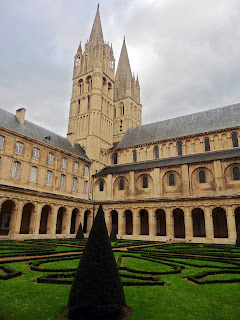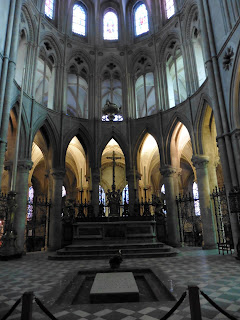We landed in Paris early in the morning - I am a huge fan of overnight flights when heading east - and grabbed a rental car and hit the road to drive up to Normandy. I’m a big history buff and I’m particularly interested in World War II because my grandpa fought in the European Theater. We sort of inadvertently ended up following in some of his footsteps on this trip, which made it even more interesting than it would’ve been otherwise.
Our first stop was, embarrassingly, a McDonald’s we found along the highway. I’m normally very opposed to eating at places like that when overseas, but we were starving and needed something fast if we were going to get to do anything in Normandy that afternoon. We did enjoy the novelty of getting to order a “McBeer” with our combo meals though. American readers will be happy to know that Mickey D’s chicken nuggets taste the same in France as they do back home.
We once again hit the road and made it to Caen, a city whose pronunciation we debated until finally looking it up on Youtube. None of us had been right. Though our stated purpose for visiting Normandy was to see WWII attractions, our first stop on vacation was a step much, much further back in history. We were going to see the Abbey where William the Conqueror's tomb is located.
Admission to the abbey was free, and there was also a small art exhibition going on in one of the wings. We wandered through the cloister for a few minutes before setting out to actually enter the main building. In order to get inside, we had to walk back out the front entrance we had come in through and go all the way around the outside of the church until we found a tiny, unmarked door. We would’ve missed it if another group of people hadn’t exited as we were walking by.
 |
| The cloister |
The abbey was founded in 1063 and was luckily spared from the heavy fighting around Caen during WWII. I found it to be appropriately gloomy inside, but the scale of the architecture was truly astounding. I’m consistently blown away when I see such old buildings that were constructed without modern machinery with such high vaulted ceilings and intricate details.
 |
| William the Conqueror's tomb |
William the Conqueror’s tomb was right in the center of the altar, though I found out later that his body isn’t actually there anymore. It was evidently removed during religious wars in the 1500s and all but one thigh bone was lost.
After we finished wandering inside the abbey, we walked over to another church we had spotted on the way in. It was called Eglise Saint Etienne-le-vieux and had been heavily damaged by bombs during WWII and you could see the striking remains from quite a distance away. The main tower still stands, but much of the rest of the building lies in ruins. The proximity to the main abbey that survived the war really drove home the randomness of the destruction that the war brought as the opposing armies battled across the continent.
After we finished wandering inside the abbey, we walked over to another church we had spotted on the way in. It was called Eglise Saint Etienne-le-vieux and had been heavily damaged by bombs during WWII and you could see the striking remains from quite a distance away. The main tower still stands, but much of the rest of the building lies in ruins. The proximity to the main abbey that survived the war really drove home the randomness of the destruction that the war brought as the opposing armies battled across the continent.
 |
| Saint Etienne-le-Vieux |
A little further down the road, we stopped at the Musee Memorial de la Bataille de Normandie in Bayeux. It was starting to get late, so we only had about an hour and a half to see everything. The museum had a lot of army vehicles and uniforms that were used in the battle, but I wouldn’t consider it a must-do. One of the cooler things was an old mobile radio truck that could be used to monitor communications from anywhere on the battlefield. I also liked seeing a tank crew uniform because my grandpa was part of a tank crew and I’ve seen pictures of him dressed the same way.
 |
| An American tank crew uniform |
Read more about our trip to France, Belgium, and Luxembourg:
- Arromanches-les-Bains
- American Normandy
- Disneyland Paris - Sequoia Lodge
- Disneyland Paris - Disney Village
No comments:
Post a Comment